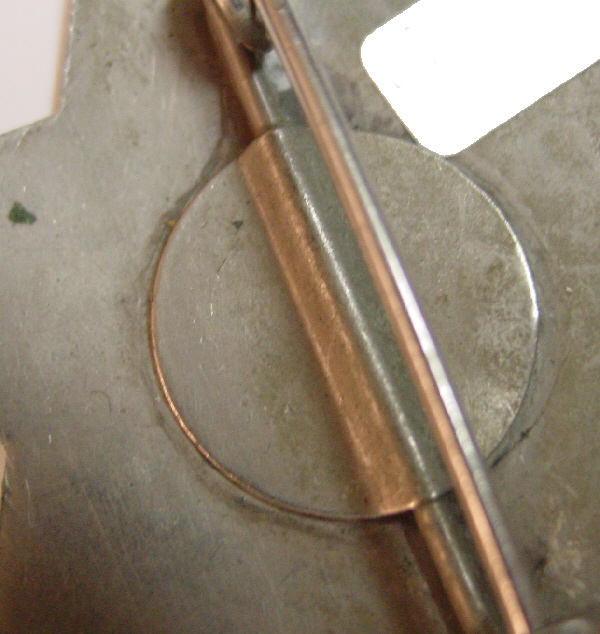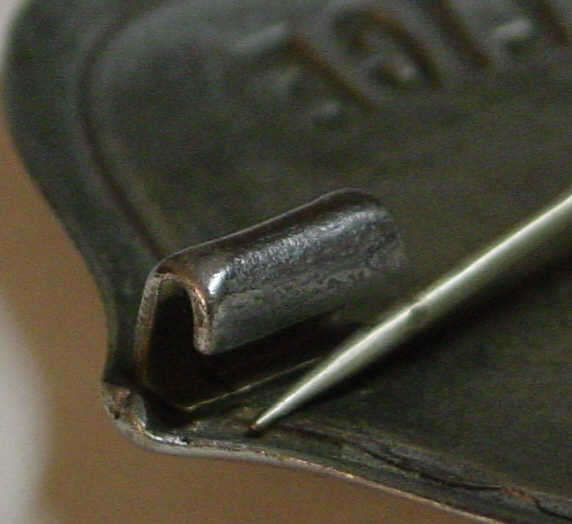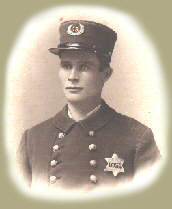|
Click on the
thumbnail
|
|

|
A common catch in the 1800s
and into the early 1900s was the "C catch", seen
here. It was simple, a heavy gauge wire formed into a C shape and
the pin was held in by its own tension. |
|
|
|

|
A good example of an 1800s pin
anchor, much cruder than today's machined pin and anchor. This one
is on the badge that contains the C catch above. |
|
|
|
|

|
This is what is known as a
"wire pin and catch", made of one single piece of medal,
formed around in one piece to make both the pin and catch. This
badge is from the 1800's and typifies the style of attachment you'd find
on a badge this age. |
|
|
 |
This is a heavier version of
the wire pin and catch and it uses a "saddle" to attach to the
badge. Commonly referred to as a "saddle pin", these
were often found on larger badges such as the pie plates, though
the smaller wire pin and catch can also be found with a
saddle as well. |
|
|
 |
Another variation of a saddle is this round version. You will also
find rectangular in addition the oblong one above.
|
|
|
 |
This thin strip of metal was used by a Boston maker just to give the
wire pin a little better support. It would also be considered a saddle.
|
|
|
 |
A rare saddle on this junior police badge (see front in the Generics
section) uses no solder. Instead, small tabs actually formed in
the badge blank are folded to hold it in place.
|
|
|
 |
Another catch from the 1800s and early 1900s was the "tongue
catch". While it is similar to the "C
catch", its flat band-like qualities appear more like a
tongue. Often it has a rounded end, much like the shape of a
tongue though this one is flat.
|
|
|
 |
Here's a view of the more common tongue-like shape of a tongue
catch.
|
|
|
 |
The "tunnel catch" is similar to the tongue
catch but a wider band forms a tunnel which seats the pin. Again,
heavily used in the 1800s and early 1900s, depending on
manufacturer. This can also be referred to as a "tube
catch"
|
|
|
 |
This catch is known by two
names. Either a "sideswing catch" or a "fork
catch" because of the three "tines" it forms when fully
open. It is a catch typically found on early to mid- 1900s
badges. |
|
|
 |
This is known as a "small
Burgess" catch. It was patented in the 1910s and became very
common thorugh the 1950s and into the 60s. The term
"small" refers to the footprint where it attaches to the
badge. It can easily be identified by the "Mickey Mouse"
ears on the swivel portion. |
|
|
 |
By the 1960s, the "large
Burgess" came into use, replacing the small Burgess with a larger
footprint to give a bigger area for soldering. The swivel features
the same "Mickey Mouse" ears as the small Burgess. This
style catch is still in use today and is most predominant in the
manufacture of badges. It is important to know and recognize this
catch because you will find it on many reproduction badges. Many
times collectors will be offered and "authentic 125 year-old
badge" with this catch, which wasn't even produced until circa
1960s. |
|
|
 |
This is a variation of the Burgess catch but because of the round sides,
it is commonly known as the "ball catch".
This one is a top loading ball catch and the manufacturer used a round
disk to mount it and the pin anchor to the badge. Another
view.
|
|
|
 |
Another ball catch but this one is side loading and
attached directly to the badge. Another variation (not shown) is a
football-shaped catch known as a "bullet catch"
|
|
|
 |
The "Bar Pin" is named so because of the flat
bar that is used as a base to attach the pin and catch as a single
piece. The catch is usually a variation of a Burgess. This
finding is typically "cheap" for manufacturers and found on
less expensive badges. Generally believed to be used from the
1950s on, they are also found on older badges as a replacement pin once
the original was broken. This one was a replacement as is
evidenced by the lack of nickel plating on it. |
|
|
 |
This 1949 badge has had its saddle pin replaced with a bar
pin as is evidenced by the remains of the solder that once held the
saddle. This came direct from the department in this repaired
condition. |
|
|
 |
"Lug Backs" are commonly found
in the NYC area. A large pin secures the badge to the uniform |
|
|



















